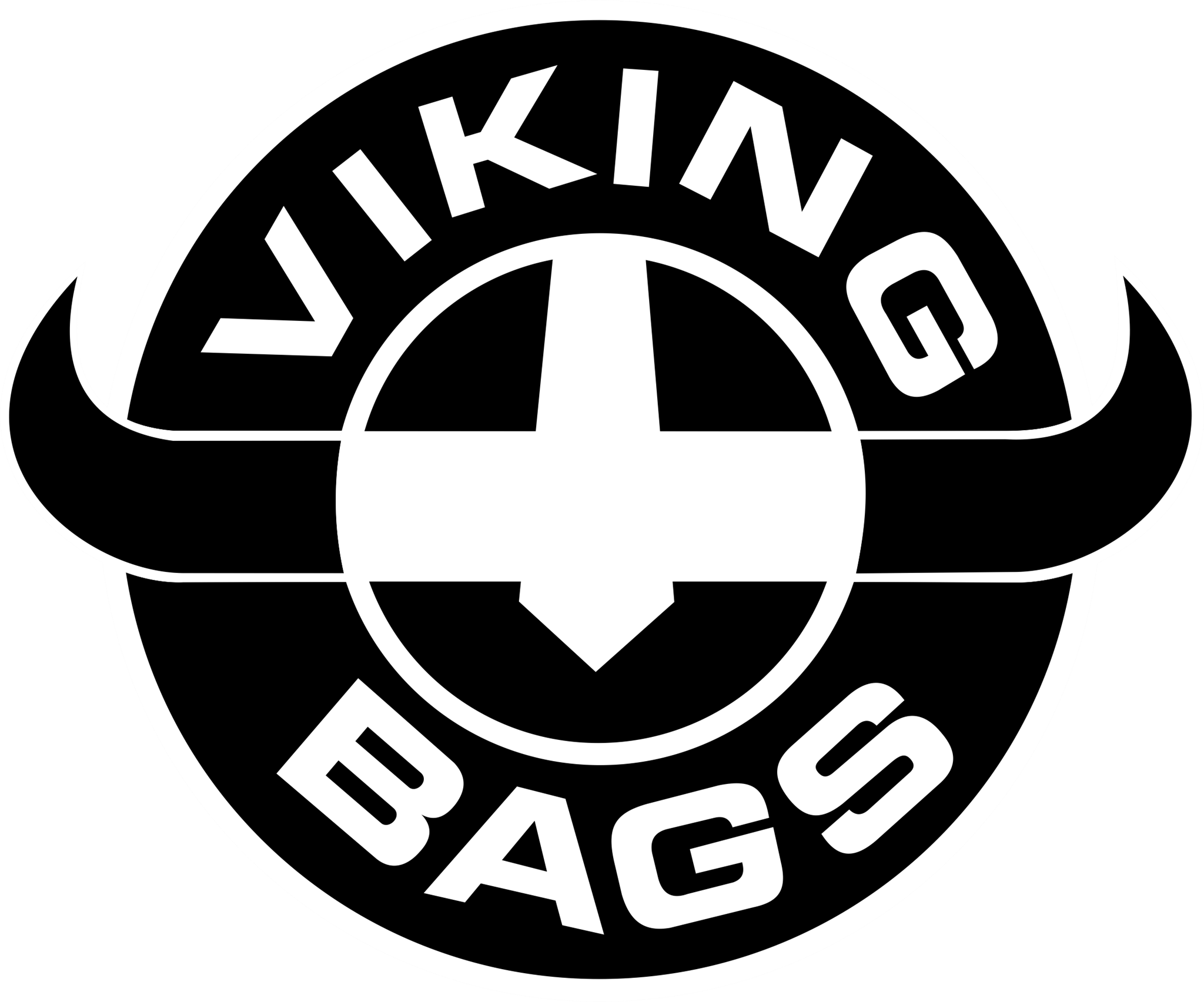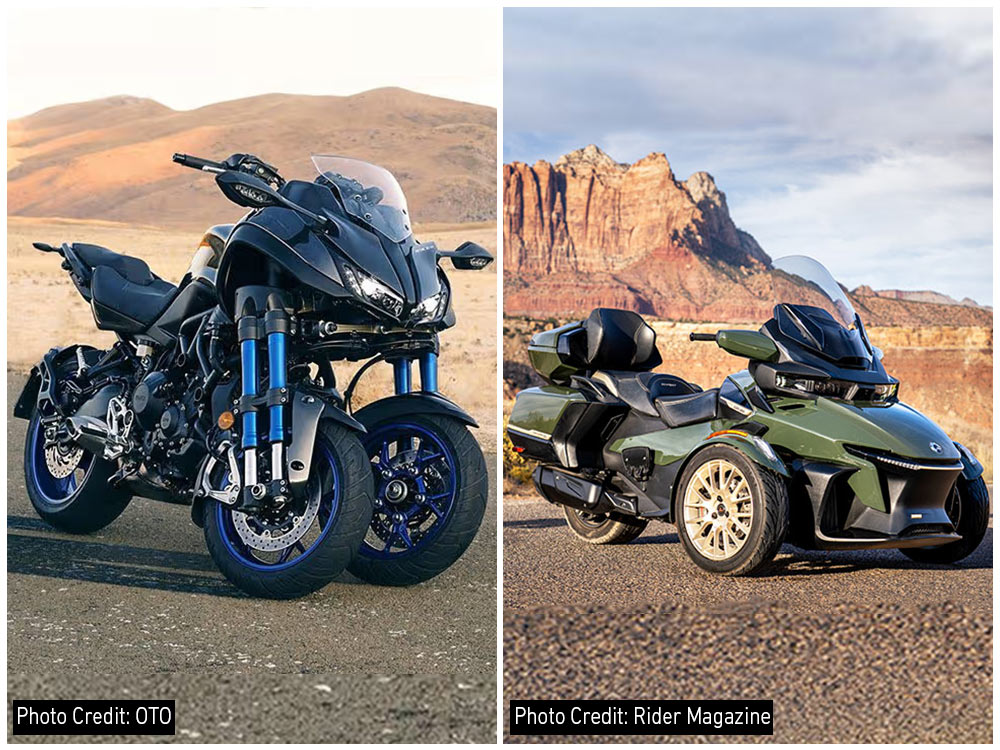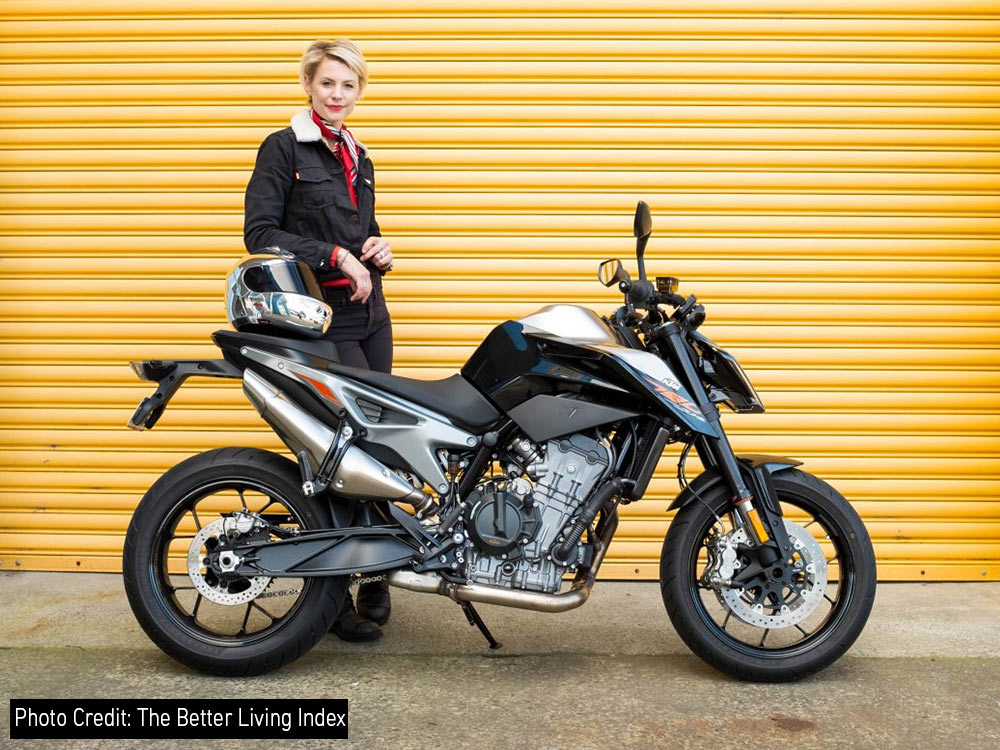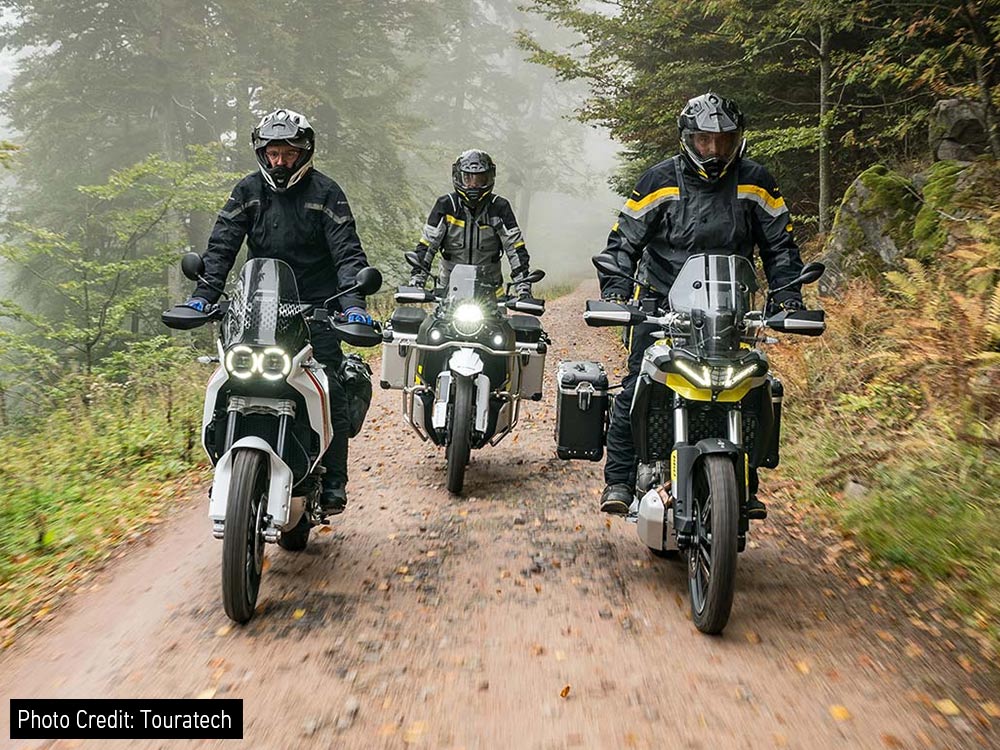Table of Content
A typical image of a motorcycle that comes into your mind shows its two wheels leaning into turns while it speeds across open roads. A motorbike breed has reshaped the normal two-wheel bike design. The world of bikes also introduced two front-wheel machines that bring together technical change, stability, high performance, and futuristic design standards.
This article explores the unique bike category by studying two dominant models, the Yamaha Niken and the Can-Am Trikes. Continue reading this article to learn about motorbikes with two front wheels.
1. Motorbikes with Two Front Wheels
Bikes using two wheels in front receive two common names, "trike" and "three-wheeled bike." When it comes to trikes, the models differ greatly from one another.
Trikes, with their standard setup, possess a single wheel in front alongside two wheels in the back, but the two front wheels take the lead over the one rear wheel in these models.
Reverse trikes and leaning multi-wheel vehicles (LMW) are the technical terms for bikes with two-wheel front setups. The most popular bikes with reverse trike setup include the Yamaha Niken and Can-Am Trikes.
2. Motorbikes With 2 Front Wheels: What’s the Point?
Two front wheels in a motorbike exist to create better stability and grip performance. Here’s how it works:
Double front wheel contact increases total traction performance by ensuring the surface area is two times that of the surface. It provides better stability and control in wet or slippery conditions.
A bike equipped with two front wheels shows better low-speed stability than normal bikes, thus providing a safer handling experience in traffic and while moving in the parking area.
The Yamaha Niken design allows riders to lean into corners through its unique leaning mechanism, which preserves two-front wheel stability, thus lowering the chance of sliding or loss of control.
Being self-balanced with better stability than traditional two-wheel bikes leads to lowered rider fatigue. Riders have to put in good effort to keep a bike balanced on two wheels. Therefore, riding a three-wheeled bike or trike offers comfort during long rides.
3. Yamaha Niken: The Game-Changer in Motorcycling

Among the most known and unique 3-wheel bikes with dual front wheels is the Yamaha Niken. The Yamaha Niken is beyond simplicity. It is a unique motorbike. Here’s what makes it special:
3.1 Design and Engineering
The Leaning Multi-Wheel (LMW) technology by Yamaha stood as the main design element in the Niken creation. The system allows each front wheel to rotate separately, which produces motorbike-like leaning motion and results in unmatched stability performance. The bike has an 847cc three-cylinder liquid-cooled engine that generates 113 horsepower.
3.2 Performance and Handling
This Yamaha Niken model is built to deliver sportbike excitement and provide extra stability benefits. The Niken model can reach 125 mph while demonstrating solid handling because of its unique three-wheel frame. The bike features a special layout that lets new and skilled two-and-three-wheeled bike operators experience safety and comfort while riding.
3.3 Can the Yamaha Niken Fall Over?
Stability features appear the same in the Yamaha Niken as they do in standard two-wheeled bikes. It can also fall over. However, standard bike models have more risk of falling than the Yamaha Niken.
The Yamaha Niken exists between typical motorbikes and the category of trikes. Removal of the stand would cause the Niken to fall down.
3.4 Is Yamaha Niken Discontinued?
Across various regions, customers can still acquire the Yamaha Niken. The availability of this product caters to customers who seek rare riding products.
3.5 Yamaha Niken Price
Premium technology fans with performance demands can get the Yamaha Niken starting from $17,000. Used Yamaha Niken models are available to customers across the market, enabling them to acquire these vehicles at low prices.
4. Can-Am Trikes: The Ultimate Three-Wheel Touring Machines

The company Can-Am functions as part of Bombardier Recreational Products (BRP) to build motorbikes with two front wheels and a single rear wheel. The trike lineup from this manufacturer stands unique for delivering both comfort features and strong performance, therefore making it best for touring applications.
4.1 Design and Features
The Can-Am Spyder series, among other manufacturers' models, places emphasis on delivering great comfort during long trips. Can-Am Trike motorbikes include two front wheels as well as heated handgrips and infotainment systems and offer plenty of storage space. The stability system of Can-Am Trikes functions by keeping its two front wheels fixed in place instead of using the leaning mechanism found in the Niken.
4.2 Performance
Can-Am Trikes receive their power from a wide range of strong engine capacities between 600cc up to 1,330cc. Can-Am Trikes put cruise function above sport features to ensure smooth riding performance.
5. Yamaha Niken vs. Can-Am Trikes vs. Standard Two-Wheel Motorbikes: A Detailed Comparison
Motorcycling now extends its boundaries to exceed two-wheel vehicle operations. Yamaha Niken and Can-Am Trikes represent modern, creative bike designs that deliver enhanced stability functions while allowing special engineering abilities.
The evaluation compares two-front-wheeled bikes to standard two-wheel bikes. A detailed assessment will investigate bike design aspects followed by handling ability, stability, performance, ergonomic features, engine power, and turning attributes.
5.1 Construction
5.1.1 Yamaha Niken
The Leaning Multi-Wheel (LMW) system on the Yamaha Niken depends on its light aluminum frame design.
A modern parallelogram suspension maintains front wheel stability through independent wheel leaning and, at the same time, maintains stability.
Through its inline-three liquid-cooled engine, the Niken delivers 113 horsepower and 64 lb-ft torque.
The heavy mass of 580 pounds (263 kilograms) makes the Niken exceed standard bike weight due to its latest front-end design features.
The Yamaha Niken functions as a motorbike in its design, although it retains bike traits. The front design projects a sports-touring bike looks except for its dual front wheels design.
5.1.2 Can-Am Trikes
Each Can-Am Trike model, including all Spyder editions, uses a steel frame structure to deliver both strength and balance to the vehicle.
The Can-Am Trike achieves independent front-wheel suspension through a two-front-wheel system that delivers a stable riding performance.
Can-Am allows customers to choose from engines ranging from 600cc to 1,330cc with specific power output rates for each model design.
The touring design purpose behind Can-Am Trikes results in these vehicles carrying weight beyond 1,000 lbs (454 kg).
5.1.3 Standard Motorcycles
Standard bikes use steel, aluminum, or carbon fiber structures to build their frame depending on the sportbike, cruiser, or other groups.
The single front wheel functions with a telescopic fork that provides quick handling.
Bike engines can have capacities starting from 125cc all the way up to 1.000cc+ capacities depending on how riders want to use them.
Standard bikes have a weight lower than that of three-wheel bikes when measured on average.
5.2 Handling
5.2.1 Yamaha Niken

The LMW system on Yamaha Niken enables the bike to perform motorbike leaning motions like a standard two-wheel bike. Regarding stability performance, the three-wheel bike beats other biking types. The Yamaha Niken achieves modern cornering performance on different terrains using its double front wheels, which maintain stable operations.
This bike uses two wheels on the front to create extra contact areas that grant improved grip control and traction potential.
5.2.2 Can-Am Trikes

- The Can-Am Trikes behave like a car instead of a bike during operation. Two front wheels are fixed into place, which results in stability but lower control. Can-Am trikes cannot lean while turning a corner.
5.2.3 Standard Motorcycles

Standard bikes deliver the highest level of control because they remain quick and responsive. Operating these vehicles demands skilled handling because they become challenging to manage during slow-speed operation and when moving through tight spaces.
Because of its single front wheel layout, the bike offers great agility, which suits aggressive riding situations and fast movements.
5.3 Stability
5.3.1 Yamaha Niken
The Yamaha Niken achieves great stability because it combines dual front wheels with the LMW system, which operates perfectly under wet and slippery road conditions.
The stability provided by dual front wheels enables new riders and careful bikers to choose this bike as their first bike.
5.3.2 Can-Am Trikes
The Can-Am Trikes stand out as the most stable vehicle due to their two-front-wheel design. Riders looking for safety in their bike choice will like that these vehicles are very difficult to flip over.
Without leaning ability, these bikes provide a less active performance when cornering.
5.3.3 Standard Motorcycles
Standard two-wheel bikes show the least stability during slow speeds as well as when riding over rough terrain. Riders need constant balancing techniques and riding skills for safe operation.
Standard two-wheel bikes recover more quickly from tipping because they are light.
5.4 Performance
5.4.1 Yamaha Niken
The Yamaha Niken is equipped with its 847 cc engine, ensuring 113 hp of horsepower and achieving speeds up to 125 mph. Engineers built this bike to satisfy the needs of riders looking for high-speed motorbikes with superior stability.
Thanks to its LMW system, this bike delivers great traction and stability, which results in reliable slowing down and speeding up control.
5.4.2 Can-Am Trikes
Touring and comfort features form the main focus of Can-Am Trike motorbikes instead of performance abilities. Cruising power takes priority over speed performance in this line of three-wheeled bikes because their engine sizes range between 600 cc and 1,330 cc.
Different Can-Am Trike models reach high speeds between 110-120 mph.
5.4.3 Standard Motorcycles
Performance among standard two-wheel bikes stands greatly different based on their type. Neither cruisers nor touring bikes are designed for reaching high speeds since they prefer torque and cruising comfort instead of high top speeds like sportbikes do.
Skilled riders find the most thrill with standard two-wheel bikes because of their performance abilities.
5.5 Cornering
5.5.1 Yamaha Niken
A cornering feature on the Yamaha Niken exists due to its LMS system. This bike uses two front wheels alongside natural leaning motions, which provide improved corner operation, similar to two-wheel bikes.
Higher speed cornering is possible for bike riders since they avoid the risks of traction loss and control failure that cause tipping over.
5.5.2 Can-Am Trikes
Using Can-Am trikes for cornering produces a driving experience similar to cars because their motorbike design lacks lean abilities. These bikes stay stable in upright positions but deliver an experience below that of motorbikes that lean.
Can-Am riders must slow down before bending around corners because the wheels stay fixed in position, thus lowering their movement ability.
5.5.3 Standard Two-Wheel Motorbikes
Standard two-wheel bikes lead all other motorbikes since they possess unmatched steering abilities during cornering. Skilled riders achieve great lean during high-speed travel on their bikes.
Bike learners who want to improve their cornering abilities must learn modern bike handling skills along with confidence before they ride in wet or slippery conditions.
5.6 Riding Style
5.6.1 Yamaha Niken
Designers combined sport-touring functionality with stability aspects when creating the Yamaha Niken model. The bike offers sports bike excitement alongside better stability, which creates greater safety assurance.
This three-wheeled bike meets all riding requirements, from curves to highway journeys and regular commute purposes.
5.6.2 Can-Am Trikes
Touring and cruising require the special features of Can-Am trikes, which are excellent three-wheel bikes. The trikes deliver top-notch comfort through their stability framework, which benefits users seeking easy operation instead of sporty performance.
The Can-Am trikes fulfill both long-road expeditions and passenger-carrying tours. Such bikes provide the ideal experience for people who prefer controlling their three-wheeled motorbikes with handles.
5.6.3 Standard Two-Wheel Bike
The two-wheel bike platform covers both fast, aggressive operation and leisurely cruising modes.
Standard two-wheel bike models offer great riding choices, yet users need to show adequate riding abilities.
Motorcyclists in search of rear bikes should consider buying standard two-wheel motorbikes.
5.7 Ergonomics
5.7.1 Yamaha Niken
The Yamaha Niken features a supported sitting position because its seating system harmonizes with handlebars that easily reach the operator. The bike enables extensive travel while decreasing exhaustion among riders.
Nearly all Yamaha Niken footpegs are mounted further toward the back of the bike than mid-position feet platforms found on regular roadster bikes. Based on design considerations, the Niken saves enough space for comfortable sitting and leg placement.
5.7.2 Can-Am Trikes
The Can-Am trikes provide great comfort by offering spacious seats with built-in backrests, and their control systems are designed for comfortable use. The seat heating function is available on several Can-Am trike models, together with high-end media systems that match automobile standards.
The riding posture supports an easy and relaxing seated position aimed to enhance the touring experience.
5.7.3 Standard Two-Wheel Motorcycles
Standard two-wheel bikes differ in their ergonomic traits based on the bike type. The riding positions between sport bikes and cruisers and touring bikes stand opposite with the aggressive forward-leaning stance on sport bikes compared to the upright, relaxed seating on cruisers and touring bikes.
Touring bikes achieve their best feature for long trips through specially designed aspects.
6. Conclusion
Motorbikes equipped with two front wheels are considered to be a new advancement in bike engineering. Riders have access to many choices when it comes to bikes.
Three-wheel bikes, also known as trikes, provide better stability than handling. For example, riding a Can-Am trike doesn’t require riders to balance it while parked or stopped at the traffic signal. They stay upright and don’t drop to one side when parked.
On the other hand, the Yamaha Niken is a more modern version of a trike motorbike. With its modern LMW system, it can lean just like a standard two-wheel bike while being highly stable like a three-wheel bike.
The creative engineering, along with superior stability and modern appearance of motorbikes with two front wheels, is reshaping the standard idea of two-wheel riding.
The market offers multiple options for two-wheel bike buyers. Despite your experience in motorcycling, the world of bikes with two front wheels will welcome you to have a unique riding experience.
7. Frequently Asked Questions (FAQs)
7.1 What Is a Motorcycle With Two Wheels in Front Called?
Generally, a motorcycle with two wheels in front is called a reverse trike. The wheels are attached in the Y-setup. The most common examples of motorbikes with two wheels in front are the Can-Am Trikes and the Yamaha Niken. We have mentioned these as the best examples of bikes with two front wheels because they use handlebars as their steering mechanism.
On the other hand, there are also many other trikes with two front wheels and a single rear wheel. However, these vehicles blur the line between bikes and cars as they also feature a steering wheel as their steering mechanism. The most common examples include the Polaris Slingshot and the Campagna T-Rex.
However, the most common trike motorbikes are the regular trikes with one wheel in the front and two wheels in the rear in an inverted Y-setup.
7.2 Why Do Some Motorcycles Have Two Front Wheels?
Some bikes have two front wheels to ensure high stability. Such bikes, also known as trikes, do not require kick stands or riders to balance with both their feet touching the ground. They stay upright across the ride or when they are parked.
Motorbikes with two front wheels are usually designed for riders who want a driving experience. It is suitable for beginner riders as well as older riders. Learning how to ride a bike with two front wheels is also easier compared to a standard two-wheel bike.
7.3 Are Trikes Safer Than Motorcycles?
The main concern people have about motorcycles that use two front wheels together with one rear wheel pertains to safety levels relative to standard bike designs. The response to this question is an unambiguous yes. The increased stability, together with better traction and a lower incidence of tipping, provide trikes with superior safety traits that benefit riders, including beginners or people with physical disabilities.
7.4 What Is the Point of a Yamaha Niken?
The Yamaha Niken is a revolutionary motorbike design and an upgraded version of an inverted trike motorbike. On top of having two front wheels, the Niken also has a leaning system, allowing riders to lean in corners while maintaining superior stability with its three wheels. The Yamaha Niken provides a lean angle of 45° on both sides. The point is to create a trike motorbike with the superior stability of a three-wheeled bike and the control of a standard two-wheel bike.










Leave a comment
All comments are moderated before being published.
This site is protected by hCaptcha and the hCaptcha Privacy Policy and Terms of Service apply.